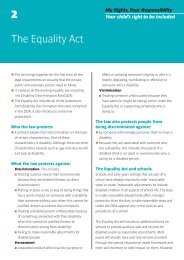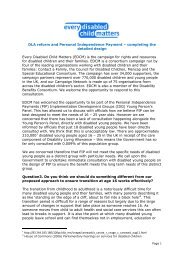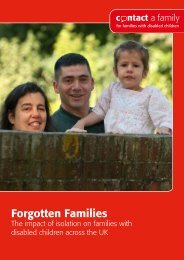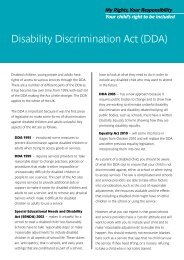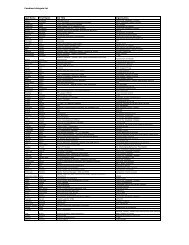Early years and the Disability Discrimination Act 1995 What service ...
Early years and the Disability Discrimination Act 1995 What service ...
Early years and the Disability Discrimination Act 1995 What service ...
Create successful ePaper yourself
Turn your PDF publications into a flip-book with our unique Google optimized e-Paper software.
14 <strong>What</strong> happens if a disabled child is discriminated against?<br />
Where <strong>the</strong>re has been unlawful discrimination <strong>the</strong>re is a means of redress.<br />
Part 4<br />
A claim of unlawful discrimination under Part 4 of <strong>the</strong> DDA:<br />
●<br />
●<br />
●<br />
is made by <strong>the</strong> parent of a disabled child;<br />
<strong>the</strong> claim is made to <strong>the</strong> SEN <strong>and</strong> <strong>Disability</strong> Tribunal, or in certain<br />
cases to a local admissions or exclusions appeal panel;<br />
if <strong>the</strong> SEN <strong>and</strong> <strong>Disability</strong> Tribunal determines that <strong>the</strong>re has been<br />
unlawful discrimination, it can order any remedy it sees fit, but no<br />
financial compensation is available.<br />
Part 3<br />
Where <strong>service</strong>s are covered by Part 3 of <strong>the</strong> DDA (providers o<strong>the</strong>r than schools):<br />
● a claim of discrimination is heard in <strong>the</strong> County Court;<br />
● if <strong>the</strong> Court determines that <strong>the</strong>re has been unlawful discrimination, <strong>the</strong><br />
remedies available include financial compensation.<br />
Under Parts 3 <strong>and</strong> 4<br />
There are many sensible measures that settings can put in place to prevent a<br />
difficulty becoming a claim of discrimination. Firstly, it is good practice<br />
(<strong>and</strong>, where <strong>the</strong> setting is in receipt of government grant, a necessary part of<br />
a settting’s SEN policy) to have a complaints procedure that is widely known<br />
to parents. A complaints procedure usually starts by asking parents to raise<br />
any difficulty with <strong>the</strong> person in charge. If this does not lead to <strong>the</strong><br />
resolution of <strong>the</strong> difficulty, <strong>the</strong> procedure is usually to take <strong>the</strong> complaint to<br />
<strong>the</strong> management group, governing body, proprietor or, in some cases, to <strong>the</strong><br />
LEA. Beyond this, <strong>the</strong> <strong>Disability</strong> Rights Commission may be able to help.<br />
The Commission provides a confidential help line, with access to information<br />
<strong>and</strong> advice for providers, parents <strong>and</strong> disabled people. In addition, <strong>the</strong><br />
Commission runs a conciliation <strong>service</strong>. This <strong>service</strong> may be able to assist<br />
in <strong>the</strong> resolution of <strong>the</strong> difficulty without <strong>the</strong> need to go to <strong>the</strong> courts or to<br />
<strong>the</strong> SEN <strong>and</strong> <strong>Disability</strong> Tribunal. Using <strong>the</strong> Commission’s conciliation<br />
<strong>service</strong> does not affect parents’ recourse to <strong>the</strong> courts or to <strong>the</strong> Tribunal.<br />
Contact information is provided at <strong>the</strong> end of this leaflet.<br />
13




